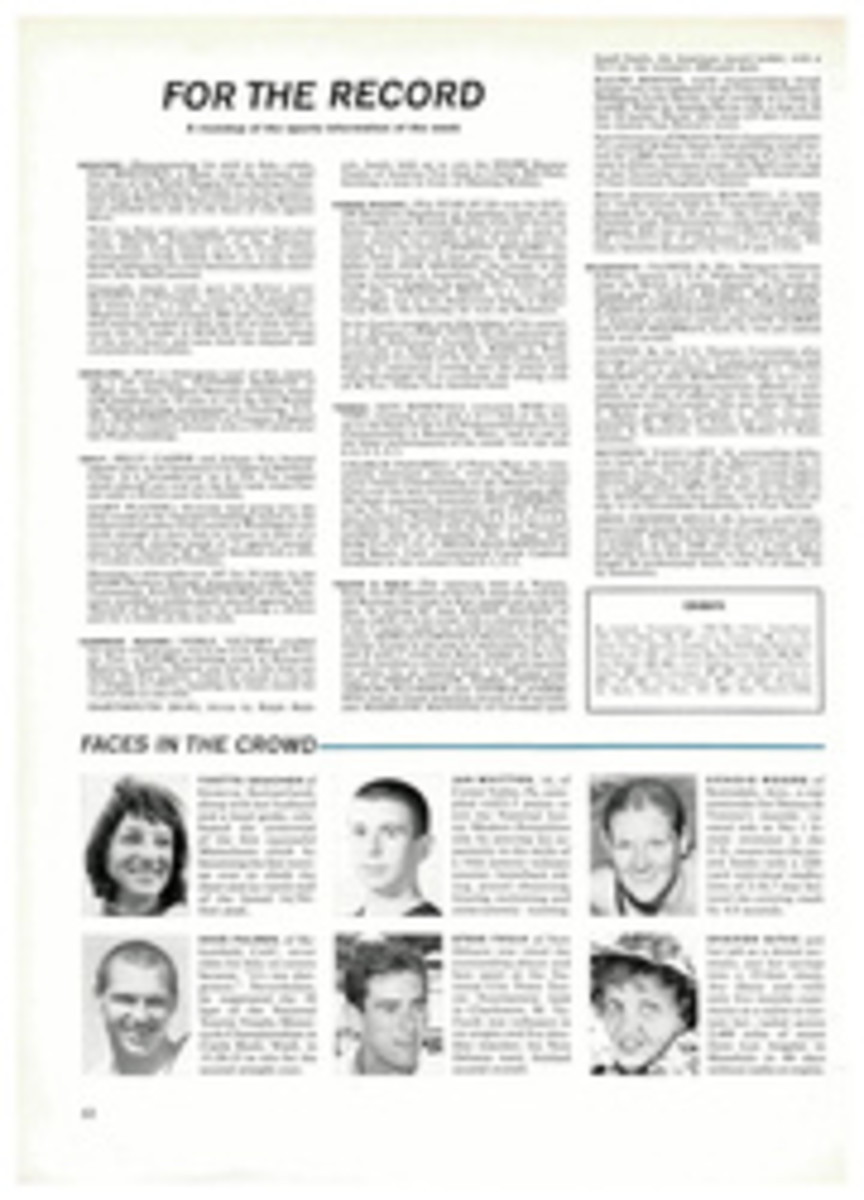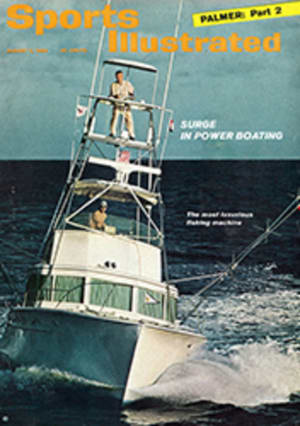
Some fanatics whose fun is playing old records
The man at left running with such dedication through New York's Central Park to no apparent purpose, is a nut. People look at him and say, "There goes a nut." His name is Jim Dunaway, he is an advertising man and where he would most like to be on July 31 is Kiev, Russia, site of the seventh U.S. vs. U.S.S.R. track meet. If he was there he would doubtless be up at dawn jogging through Sovyetski Park, where people would look at him and say, "There goes a nut." But what they don't know, either in Kiev or Central Park, is that Jim Dunaway is more than a nut, he is a Track Nut. He is also proud of it.
Track nuts are not to be confused with either park runners or track fans. There may be hundreds of thousands of the latter throughout the U.S. and the world, but there are probably no more than 10,000 track nuts. At least that is the circulation of their bible. Track & Field News, which is published monthly by the brothers Cordner and Bert Nelson, at Los Altos, Calif., and supplemented during the indoor and outdoor seasons by a weekly Track Newsletter.
The difference between fan and nut is considerable. A fan can take a track-and-field meet and leave it, but a nut is never done with it. He must study it and analyze it and fit it into his encyclopedic knowledge of other meets. A fan is content to remember who won what and at what time, height or distance. A nut will record such data as the 110-yard clockings for 440-yard races. Cordner Nelson recalls listening to Track Nut Hugh Gardner give a history of Indiana High School milers as far back as the records went. Track Nut Art Hoffman of Los Angeles prides himself on having seen 64 sub-four-minute miles run on the North American continent, starting with Roger Bannister's victory over John Landy in the British Empire Games at Vancouver in 1954.
All sorts of track nut prowess are demonstrated at the bull sessions that inevitably take place at big meets. One occasion of this kind involved Kenneth S. Greenberg, Los Angeles attorney, who—holding a beer bottle aloft like an Olympic torch—recited the 200 best broad jumps of the U.S., Europe, Asia Africa and way points, in order. A nut must be sure of his facts on such occasions. If he should be in the act of reciting the last 97 pole-vault records, for instance, and should miss the 57th, a half dozen of his associates will be on their feet to stop him cold.
Sometimes at the bull sessions nuts will test one another's knowledge by singing out dates or places where notable events occurred. For example, "Ann Arbor, Michigan." This should bring an instant response: "Three world records set by Jesse Owens, May 25, 1935. New broad-jump record of 26 feet 8¼ inches, 220-yard low hurdles in 22.6, 220-yard dash in 20.3." For good measure it might be added that Owens tied the 100-yard dash record of 9.4. That is too easy, of course, for a track nut. A better test might be August 6, 1958. The answer: Herb Elliott set a new mile record at Dublin in 3:54.5, with the next four men to finish also under four minutes.
Not all members of this strange band of fanatics dote on statistics alone. Some prefer to talk about fine examples of technique, and that is what they watch for. A technique specialist will concentrate on the high jumpers to see when they start ducking before takeoff, or the vaulters to note whether they obtain the same bend from their poles every time.
Generally speaking, track nuts do not mind being called track nuts. Their own official publication so refers to them, and to be mentioned as TN John Brown, say, is accepted as a title of respect. For a time membership cards were distributed by Track & Field News, identifying the holders as TNW (Track Nut of the World). The distribution of these cards was discontinued some years ago, but the editors of the News are considering issuing them again.
The wives of nuts are not always nuts. Track & Field News Editor Bert Nelson's wife is not, and Mrs. Cordner Nelson is only mildly interested in the sport. Mrs. Franklin (Pitch) Johnson, whose husband is the son of a former track coach at Stanford is, at the very most, a fan. Mrs. Henry David Thoreau, however, who entertained visiting nuts at a buffet supper in her four-story home overlooking San Francisco Bay during the NCAA meet in June, can talk track with anybody. Her husband, a distant kinsman of the man from Walden Pond, is a nut from way back, and his sons, David, 18, and Scott, 8, are already following his mental spike marks.
Some true track nuts are loath to come right out and reveal themselves for what they are—it being no advantage around the office to have the boss learn that what you remember best is the who and where of 187 broad jumps. But in California this seems to be no handicap, and the track nuts are almost exhibitionists, especially those from Los Angeles. Take Art Hoffman, aforementioned collector of North American sub-four-minute miles. Hoffman is an executive for an electronics firm, a profession which he has deserted to attend the Olympic Games in Melbourne, Rome and Tokyo, as well as 10 National AAU meets, U.S.-Russian competitions at Philadelphia, Palo Alto and Los Angeles, Pan American meets at Mexico City and Chicago and dozens of college meets up and down the country. Other well-known Los Angeles nuts include Dick Bank, an acknowledged world expert who is a real-estate developer in Palm Springs; Stan Eales, a manufacturer's representative; Mort Tenner, a schoolteacher and Don Potts, professor of mathematics at San Fernando Valley State College.
But track nuts do not have one-track minds. George Raborn of the Glendale, Calif. News-Press, for example, has written a book, How Hollywood Rates, and has seen and rated 9,408 movies since 1933. His alltime favorite movies are Gone with the Wind and King Kong, which he has seen 42 times.
Few track nuts were athletes themselves. They do not collect autographs, and they rarely seek to cultivate track coaches. They are simply content to watch individual efforts, as opposed to pro football fans who like their action in bunches or baseball fans who like team play and team strategies or prizefight followers who like bloody combat with one of the parties preferably bowed.
Nor do they all run themselves, but many, such as Jim Dunaway, do. His vocation is writing commercials for one of New York's largest advertising agencies. But in between snappy sentences he has learned everything about track and field events worth knowing. He writes and he runs. When he is in New York he works out at the West Side branch of the YMCA or in Central Park, from where he has been known to run down Fifth Avenue in his sweat clothes, en route to his home on East 51st Street.
Dunaway is a contributing editor of Track & Field News, making his knowledgeable stories available without benefit of honoraria. At certain meets he serves as compiler of summaries for The New York Times, a service for which he is paid. In 1956, working for an advertising agency in Chicago, he took a year's leave of absence and attended the Olympics in Melbourne. To help defray his expenses he set up a one-man news bureau and covered athletes who were not otherwise being closely observed by representatives of their home-town papers. After Melbourne, he continued on around the world, hitching rides on oil tankers.
Dunaway was also in Rome and in Tokyo. This year he planned his vacation carefully, and when the schedule was ready he took his wife, Joanne, into his confidence. They would fly to San Francisco, take in the NCAA at Berkeley, then dash by rented car to Sacramento for the Golden West Invitational three hours later, and finally double back to San Diego for the National AAU. Everything went according to plan, except that Joanne asked to be excused from the Golden West at Sacramento on the ground that she felt a little tired.
Dunaway didn't feel tired at all. He worked out every day at Berkeley, and in San Diego he ran three miles on the grass with Peter Snell. Snell won. Jim was also kept busy doing his summaries for The New York Times and working on his copy for Track & Field News. Even so, he found time to take Joanne out to dinner once in a while, and in one restaurant he entertained the guests by demonstrating the proper way to throw a javelin.
Joanne Dunaway, whose consuming interest was formerly the theater, now professes to be fascinated by her husband's hobby—and she can never say that she wasn't warned. On the night they became engaged Jim handed her two little boxes. Inside one was an engagement ring—standard equipment. Inside the other was a stopwatch.
PHOTO
UNWATCHED HIMSELF, track watcher Dunaway gives his favorite sport an exhausting try.

